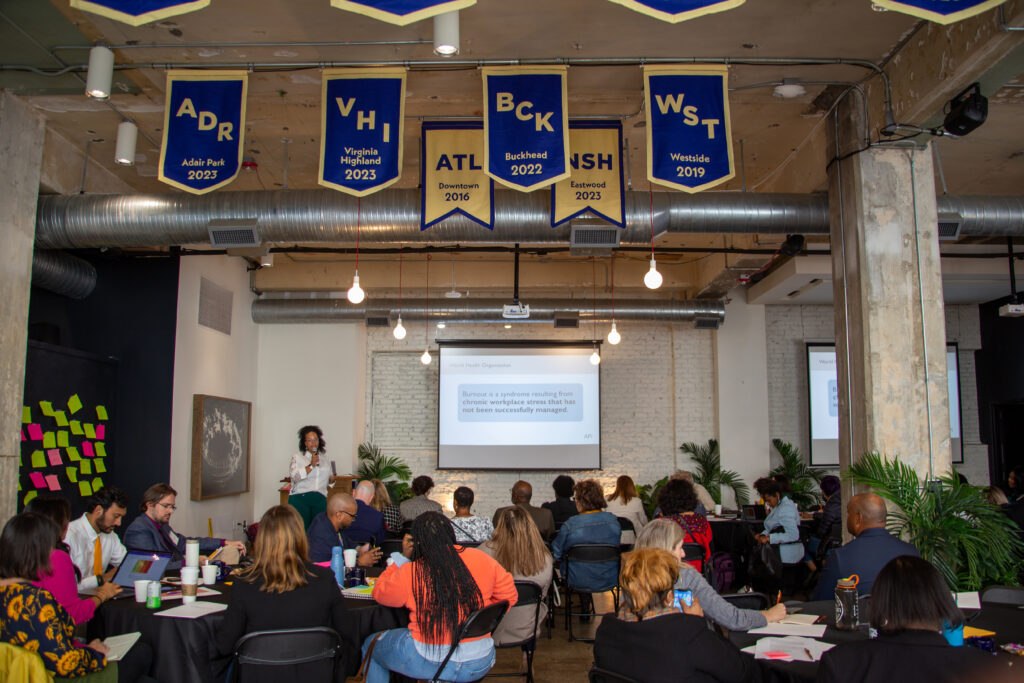For two days about 60 news leaders and mental health experts gathered for API’s Local News Summit on Mental Health and Sustainability earlier this month in Atlanta. We shared solutions and served as co-conspirators for opportunities to support the mental health and well-being of an entire industry of first — and last — responders. Many mentioned forwarding this October Mental Health challenge to their teams. Some even answered calls during the event with “you’re going to get me in trouble” because they knew the optics of dividing their attention between a summit on mental health and daily meetings, deadlines and DMs.
We didn’t compare trauma stories. We didn’t detail the daily stressors of the job. We didn’t have to. We were in the room because we know the stories, we feel the stress, and we want better — for ourselves and for the journalists we lead.
Something else we didn’t explicitly talk about was the systemic change needed to create a healthier news organization. We haven’t mentioned this yet in the October challenge either. But as many participated in the daily challenges and as summit attendees named their measurable objectives, it’s clear that this work points squarely at the organizational systems causing our industry so much harm. Let me explain.
Systemic change is hard because making decisions is hard. Changing behavior is hard. Sustaining new decisions and new behaviors is hard. But it’s not impossible.

News leaders met in Atlanta during API’s Local News Summit on Mental Health and Sustainability, October 2023.
Over the next two months, take stock of the following:
↗️ The habits you form
Start by setting your direction. A from-to statement is a concise, descriptive statement of where you are now and where you aspire to be.
🛣️ The behaviors you display
Then determine your route. This is the intentional part. What two to three behavioral decisions might you make to get you closer to the future state you noted above?
🤝 The co-conspirators you bring along
Share the plan. Changing organizational culture is a slow process, and it can’t be shouldered alone. Who can you bring along to help sustain the new behavior? How will you support each other in the short and long term?
🧾 The receipts you collect
Take stock of the signs. You know you’re headed in the right direction when you see specific things happening due to your new decisions and sustained behaviors. What receipts of proof might you anticipate?
For many newsrooms, changing the systems that protect unhealthy culture could be a few sustained decisions away from reality. I’m new to systems thinking, but I understand it to be like a bicycle. You can’t make a bicycle “better” in one shot; instead, you have to look at the parts that make the bicycle what it is, considering how each part works independently and collectively with the whole. You also have to acknowledge the conditions and assumptions involved in the design and manufacturing of the bicycle and its components.
For news organizations, some “bicycles” that impact our well-being include reward systems, communication systems and decision-making systems. Each comprises different parts: people, tools, processes and procedures, even power dynamics.
We concluded the API summit by converting an aspirational objective into a measurable goal. These goals showed us that these three systems, in particular, directly contribute to the chronic workplace stress that many of us hold in our bodies. They also contribute to our tendency to compartmentalize the impacts of traumatic exposure, racial trauma and moral injury. Many of the API Balancing Well-being Challenges also point to these systems. The “get loud” and “get grateful” challenges affect our organization’s reward systems. Likewise, the “get silence” and “get protective” challenges affect an organization’s communication systems. And finally, the “get help” and “give trust” point toward decision-making systems.
Your challenge through the end of 2023 is to connect these dots for yourself and anticipate how they may ripple through your team and organization. Systemic change may feel big, but breaking it down into these steps will help you start heading in the right direction.
DIG DEEPER
- Revisit our Mental Health Reset series to address news leadership challenges.
- Here are some ways to navigate burnout as a journalist.
- Need more specific resources? Check out our mental health resource guide.
- Bring API’s research-based mental health training into your newsroom.
Share with your network
- Balancing Well-being
- Week One Challenges
- Week Two Challenges
- Week Three Challenges
- Week Four Challenges
- Driving systemic change one behavior at a time
You also might be interested in:
Experts define moral injury as the suffering that comes from witnessing, perpetrating or failing to prevent events that violate one’s own deeply held moral beliefs and values. It is not classified as a mental illness, but it can lead to depression, substance abuse or burnout, which is one reason news managers need to understand the phenomenon of moral injury — and ways to address it or head it off.
With all of the demands on a newsroom, how do you make time to build new habits in pursuit of larger goals?
You’ve made it through the first week of prioritizing well-being! What activities made a positive impact on your day? Were there any that were difficult to accomplish?


